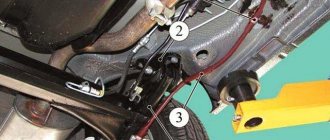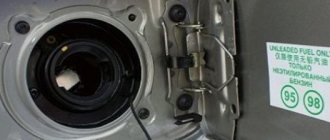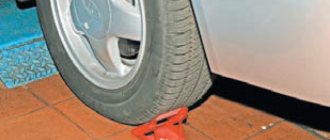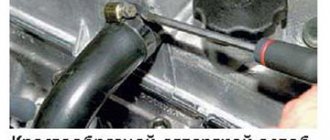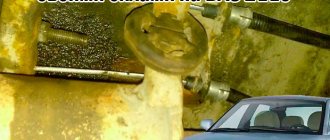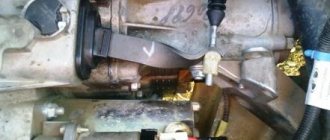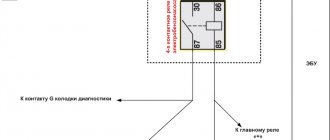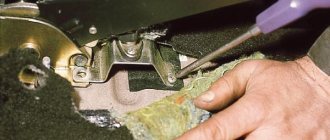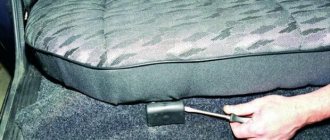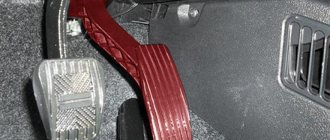Possible causes of handbrake problems
There are several reasons for the handbrake not working correctly on the Lada Kalina. Below are the main ones:
- Driving with the parking brake lever applied. One trip is enough. Brake pads wear out faster in this mode. After “driving with the handbrake” you will have to tighten and adjust the parking brake.
- Biting the cables. In a car they run along the underbody. Handbrake cables are used in extreme conditions. They are affected by dirt, moisture, temperature changes.
- Malfunction of the ratchet mechanism or jamming of the parking brake lever.
Handbrake diagnostics
To diagnose the parking brake yourself, use the inspection hole. On automobile forums, it is advised to develop the cable when it is dirty and snagged, but this measure is ineffective. Don't skimp or change, your safety is more important.
When the lever is tightened, clicks are heard. With the handbrake adjusted, there should be from two to four. In this position, the wheels should not spin. If there are fewer or more clicks, proceed to adjusting the handbrake or replacing the rod and drives.
The parking brake cable may become stuck, broken, or stretched. If the handbrake lever does not rise (does not tighten) and the car does not lock on the road, then most likely the cable is jammed. If the handbrake lever is pulled up to the end, but the car does not lock, then most likely the cable has broken or stretched.
To make replacing the handbrake cable easy and safe, we drive the car into a pit or use a lift. Raise the rear end using a jack. We remove the wheel.
Next we need to release the cable from the adjusting mechanism. It is located under the car, near the handbrake lever. To get there, unscrew the 4 nuts of the central muffler protection from the body using a No. 10 wrench. Be careful - they may rust and break off. It is advisable to treat them with WD 40.
We remove the rubber bands that secure the muffler and move the protection forward so that it does not interfere. On top of the muffler is the parking brake adjustment mechanism.
Using a long head No. 13 with a cardan, unscrew the adjusting nut and remove it from the rod.
Remove the cable equalizer from the cable adjusting rod and remove the front end of the cable from the hole in the body bracket. Then we remove the cable from the fastenings to the beam and body.
Next, remove the rear brake drum. To do this, use a long socket or wrench No. 7 to unscrew the two drum guides to the hub. With a few blows of the hammer we knock the drum off the hub and remove it.
At this stage of work, we have the opportunity to see the condition of the brake pads. There should be no peeling. If the minimum thickness is 2 mm or less, then they should be replaced. If the wear of the brake drum on the plane adjacent to the pads is more than 1 mm, then the drum should be replaced. The brake cylinder must be dry and free of brake fluid leaks and dust caps.
Next, remove the cable from the brake shoe flag, and the cable casing from the brake drum boot.
We install a new cable. To do this, simply perform all the steps in reverse order:• put the end of the new cable into the brake block flag;• thread the cable into the fastenings on the body and beam;• insert the front tip of the cable into the hole in the body bracket;• insert the ends of the cables into the equalizer, put them on the rod and tighten the adjusting nut.
Thanks for subscribing!
After the cable is installed, put on the brake drum. Tighten the guide nuts. We rotate the drum to make sure that the pads do not jam. The drum is easy to spin. We tighten the adjusting nut on the rod until the block begins to come into contact with the brake drum, this will be visible when you turn it - the drum will turn tightly.
Now you need to adjust the handbrake. We check how many clicks the parking brake lever is tightened. It is advisable to make 3-4 clicks from start to finish, while the car should be in a disengaged state.
If everything is adjusted, we put the protection in place. We screw it on. We put on the muffler rubber bands. We install the wheel. We compress the wheel mounting bolts.
How does the handbrake system work?
Applying the parking brake activates the rear brakes and ensures that the vehicle does not roll, even on a relatively steep incline. However, if the handbrake does not hold the vehicle, there is a problem that must be corrected to ensure the safety of the driver and others.
New Lada: Front wheel drive - Lada Kalina / Lada Kalina (VAZ 1118, 117, 1119)
Parking brake systems vary greatly from one automaker to another and even between different makes and models of cars. In general, they are divided according to the type of brakes and the method of their use.
It is immediately necessary to understand that in the vast majority of cases in passenger cars, parking brakes use the rear wheels and are divided into two types:
- drum - consisting of two semicircular blocks that are located inside a cylindrical drum. If, on one side, they are rigidly fixed, then on the other there is a special piston mechanism that forces the pads to move when using the handbrake;
- disc brakes - consisting of a special brake disc mounted on the car axle and two pads. When you use the handbrake, the pads compress and prevent the car from moving.
The car's braking system can also be mechanical or hydraulic. If in the first option, braking is carried out using a system of cables and the force of a person who puts pressure on the handbrake, then a special piston is used in hydraulics.
Important! Depending on the type of braking system, the reasons why the handbrake does not hold may vary significantly.
conclusions
Heavily worn parking brake cable
The cable on the Lada Kalina must be tightened every 40,000 km in accordance with the service data. But, as practice shows, this can be done earlier. For example, one or two trips with the handbrake and the cable will have to be tightened, and in the worst case, replaced.
The cable on the Lada Kalina must be tightened every 40,000 km in accordance with the service data. But, as practice shows, this can be done earlier. For example, one or two trips with the handbrake and the cable will have to be tightened, and in the worst case, replaced.
Procedure for replacing brake cables
For convenience, drive the car onto a viewing hole or overpass. Carry out the replacement with a partner: it is difficult to secure a new drive alone
. Before installing new cables, they are generously lubricated; this procedure will extend the service life and prevent the cable from biting. It’s better to change two at once, even if one is still intact.
- Perform steps 1 to 5 for adjusting the handbrake (see above).
- Unscrew the equalizer and release the left and right cables.
- Suspend the rear left or right wheel. Remove the wheel.
- Remove the brake drum. It is secured with two guides.
- Bend the clamps on the beam and the bottom of the body and release the cable.
- Disconnect the cable from the brake mechanism.
- Install a new cable.
- Install the brake drum and screw the wheel.
- Repeat pp. 3–8 for the second rear wheel.
After replacing the left and right parking brake actuators, make adjustments. How to do this is described in detail above. When replacing the rear brake pads, also make adjustments.
We recommend checking the handbrake regularly. In case of malfunction, do not be lazy to eliminate the defects. There is no need to put off repairing the parking brake - this is for your safety, including in financial terms. You don't want to be late for work one morning and find your pet stuck in a concrete parking lot, right?
In this article I will try to talk about such a procedure as replacing the parking brake cables on a Lada Kalina car. To begin with, it is worth noting that to perform this procedure we will need a lot of tools, namely:
- head for 7 mm and 10 mm
- ratchet or wrench
- extension
- deep head 13 mm
- pliers or long-nose pliers
- flat blade screwdriver
- penetrating lubricant
The first thing you need to do is drive the car into the pit, or raise the rear end to such a level that you can do everything from below without any problems. So, first we move the resonator to the side or disconnect it. In my case, it had already been filmed, so everything was quite free.
And we remove the screen from the studs without any problems.
After this, the entire handbrake adjustment mechanism is accessible. Now, using a deep socket, you can unscrew the two nuts of the central rod, as shown in the photo below.
And remove the cables from the bracket on the body. Over time, the cables may become sour in that seating area, so it is advisable to first apply a penetrating lubricant to the seating area. And when a certain force is applied, the cable is still removed from its place.
After this, we carry out further actions on the other side. First, we disengage the cable from the place where it is attached to the body.
Now you can disconnect the cable from the lever by moving it slightly to the side with a screwdriver.
And finally we pull out the cable if it is still jammed somewhere. On the other hand, everything is done in the same way. The price of a set of handbrake cables for Kalina is from 400 rubles for two pieces. Installation is carried out in reverse order.
In the Lada Kalina, as in other cars, there are many parts that over time either lose their properties or fail. Filters get dirty, brake pads wear out, and the response time of the devices increases. Setting them up does not always require the intervention of a service station; the owner can solve some problems himself, for example, adjusting the handbrake. Often it requires adjustment: they want to tighten or loosen the handbrake.
- 1 Where is it located?
- 2 How to check the handbrake on Lada Kalina
- 3 What if I replace it?
- 4 Tool for adjusting the handbrake
- 5 How to tighten up
- 6 If you need to loosen the brake
- 7 How to tighten or loosen on a station wagon and hatchback
- 8 If it doesn't help
For convenience, drive the car onto a viewing hole or overpass. Carry out the replacement with a partner: it is difficult to secure a new drive alone. Before installing new cables, they are generously lubricated; this procedure will extend the service life and prevent the cable from biting. It’s better to change two at once, even if one is still intact.
We recommend checking the handbrake regularly. In case of malfunction, do not be lazy to eliminate the defects. There is no need to put off repairing the parking brake - this is for your safety, including in financial terms. You don't want to be late for work one morning and find your pet stuck in a concrete parking lot, right?
Video on adjusting the handbrake cable
If you have any questions or the video did not open for unforeseen reasons, below is a photo report of the operation performed.
- Firstly, this work is best done on a pit or a lift, but if there is none, then you can simply lift the rear of the car higher and crawl under it.
- To get to the adjustment mechanism, you will first need to unscrew the metal casing, a kind of protection that is located between the muffler pipe and the tensioner. Its location is clearly shown in the photo below:
- Next, unscrew the 4 fastening nuts, which are indicated in the photo above. To do this, it is most convenient to use a ratchet and a 10mm socket.
Before unscrewing the nuts, be sure to spray them with a lubricant such as WD-40 and wait at least 5 minutes, otherwise the studs may tear out of the body alive even with little force.
- After this has been dealt with, it is necessary to remove the muffler hook from the rubber band, on the side that is closer to the front of the car, so that it is convenient to move forward the same metal casing that we unscrewed.
- And then we move the metal casing to the right until the handbrake adjustment mechanism becomes accessible. This is what it looks like, as shown in the photo below:
- To tighten the cable, you need to tighten the nut closest to the plate with a 13mm wrench, and then tighten the outer one too and fix the first one. It is very inconvenient to do all this, since the muffler always gets in the way and you have to turn it almost a millimeter at a time, constantly moving the key to the desired position.
- After you have made at least a couple of revolutions, check the tension of the lever. And if the working stroke is from 2 to 4 clicks, then everything is fine and you can stop working, putting everything in its place.
Attention! Do not make much effort when you put back the same plate that is located between the exhaust pipe and the tensioner, since the studs are held in the body very weakly and can again break out (which happened to my Kalina). Apply force, even less than average, because there are still groovers installed there that will not allow the nuts to unscrew!
Replacing the handbrake cable on a VAZ 2110, VAZ 2111, VAZ 2112
Lada Kalina wagon Luta Logbook Replacing the ignition switch. Fiddling with keys
Welcome! The handbrake cable - over time it stretches and becomes unusable, and sometimes it even happens that it breaks (In fact, everything depends on its quality, some cables sometimes don’t even stretch at all), all these problems associated with the cable cause a lot of inconvenience , it all starts with the fact that the car simply cannot be put on the handbrake, or it will hold the car, but very, very weakly, so to avoid such inconveniences, the cable must be replaced from time to time with a new one, this is not difficult to do and you can do it yourself You don’t even need to go to services.
Note! To carry out work on replacing the cable, we recommend that it be convenient to work: Firstly, drive the car into the inspection hole and secondly, stock up on a wrench and sockets for it, if you do not have such an opportunity, then stock up on ordinary keys, such as sockets and wrenches !
- Replacing the handbrake cable
- Additional video clip
Where is the handbrake cable located? It passes under the bottom of the car, in order to understand its location in more detail, first you will need to look at the handbrake (Indicated by a red arrow in the large photo), next to it there is a bracket, it is also indicated by a blue arrow, and so under the bottom the cable is located in exactly the same place , in general there are only three cables and the last two must be replaced as an assembly (in a pair), the first cable is the one that comes from the handbrake (Small cable, see small photo), the second two are those that are connected to the bracket, the bracket is also shown in the small photo and indicated by a blue arrow.
When do you need to change the handbrake cable? It can rust from old age, or if you don’t use it, exactly the same situation will happen, in connection with this, it will begin to move into the shell with great difficulty, will jam and may even not really hold the car, except for this problem, the cable needs to be changed when it gets loose (You can understand this by looking at it) or it has become very stretched (If the cable cannot be adjusted even by adjustment, then it has become very stretched; how to adjust the cable, read in the same article below).
Note! Immediately before starting work, remove both rear brake drums from the car, because the ends of the cable are attached to the brake pads, and without removing the drum you will not get to the pads (For information on how to remove it, read the article: “Replacing brake pads at ten")!
The counter nut is loosened and the adjusting nut rotates in the desired direction, thereby the bracket begins to move and the cable is adjusted, finally the counter nut locks the adjusting nut again and thus the cable is adjusted) and then you can unscrew both of them, when the nuts are in your hands, remove the bracket back and the main cable (it is also called a rod) will come out of the bracket (see small photo).
Note! After the operation has been completed, remove both ends of the cable from the bracket, one is shown with an arrow for clarity, and as soon as they are removed, put the bracket aside so that it does not interfere with further work on replacing the cable!
2) Now, using two screwdrivers or you can just stock up on one, remove the ends of the cable from the hooks of the levers, for more details in the photo below, see all the information, in a nutshell, the ends (One of the ends is indicated by a blue arrow) are connected to the hooks and these are needed and remove (one end for each wheel) to release the cable ends in some other places.
3) Well, finally, remove the shells of both cables from the second bracket, and also unscrew two nuts (One for each bracket), remove the additional brackets from the levers (see small photo below) and then completely remove both cables from car, but just keep in mind that they go criss-cross, so when reinstalling, don’t forget this and be sure to take it into account.
Installation: Installation of both cables is carried out in the reverse order; be sure to connect all removed brackets in their places so that the cables do not dangle or touch anything unnecessary.
Additional video: You can see the process of replacing the cable in more detail in the video located just below; in addition, it also explains the procedure for replacing the handle itself, you may need this too.
Let's sum it up
The assembly process, after the cable has been replaced, does not present any particular difficulties, so there is no point in commenting on it. The sequence of actions itself is the reverse of the dismantling procedure. Before installing the ends of the cable branches into the mounting holes on the brake shields of the Lada Kalina, do not forget to clean these openings from any dirt accumulations.
On the Lada Kalina, during operation of the handbrake, it may become stretched and will require adjustment. So, signs that the handbrake needs to be tightened are poor fixation of the car, with the handbrake raised, on an inclined surface. This bell signals that the cable needs to be tightened.
Adjust or change?
To determine whether the parking brake can be adjusted or whether it is better to install a new one, remember how long ago you replaced the brake pads and drums on the rear. On average, replacing rear pads is necessary every 50–80 thousand km, but the frequency also depends on driving style. If the pads are worn too much, the parking brake will not be effective (as will the braking system of the car as a whole) . Inspect the pads: if their thickness is less than 1.5 mm, urgent replacement is needed. Also, try opening the pads manually with a screwdriver. They should be separated without excessive force.
We recommend: Why did antifreeze turn brown?
If the thickness is within acceptable limits, pay attention to the brake drum. Measure its diameter with a caliper. If the value is above 20 cm, the drum must be replaced with a new one.
If you notice scuffs, cracks, or severe corrosion on the pads or drum, replace the damaged parts. It is not recommended for an inexperienced motorist to try to restore components.
If all the inspected components of the car are in order, but the parking brake still does not work, the problem lies in the cable. If it breaks, the handbrake will lift without any effort - in this case, the part definitely requires replacement. You can tighten the cable with your own hands, but if it is already raised to the maximum and tightening is impossible, you should go for a replacement.
There is another sign that it’s time to adjust the parking brake: when you tighten the handbrake, you hear less than two or more than four clicks of the lock. During operation, the number of clicks can be increased to six.
Replacing the clutch cable on Kalina and Priora. It's time to learn this
Lada Priora hatchback Star Maggie Logbook Replacing the cabin filter of Priora without air conditioning
- Wrenches (8, 17);
- Calipers;
- Ruler;
- Slotted screwdriver.
- At the bottom of the dashboard, using 8mm wrenches, unscrew the nut securing the cable stop to the pedal. After this, the stop is removed from the bracket;
- The locking bracket is removed from the pedal pin (clutch). The mechanism that compensates for wear of the friction disc linings must be dismantled;
- Remove the bushing from the pin. It is usually subject to wear and tear. Therefore, if upon inspection there are traces of damage and wear on the plastic, a new one should be installed. Before installation, be sure to generously lubricate the bushing with lithol or any other similar lubricant;
- The seal should be pulled out from the compartment under the motor through the shield hole; it is more convenient to do this using a screwdriver;
- Pull the cable tip (direction according to the movement), then disengage it from the clutch release fork;
- Using 17mm wrenches, unscrew the tip mount from the bracket located on the gearbox. Be sure to keep the second nut from turning;
- The tip is pulled out. Next, the cable is removed through the shield hole.
A new cable is passed through the shield hole. Immediately attach a wear-compensating device to the pedal; The cable stop is attached to the pedal mount; A seal is installed in the shield; The tip of the cable casing is installed (as carefully as possible) into the mount (located on the gearbox). Be sure to immediately tighten the nut securing it; A leash is screwed onto the tip located below
Make sure that the tip protrudes relative to the leash by 1 millimeter. Before installation, generously lubricate the tip with grease; The drive cable is installed in its original location
To do this, be sure to move the lower tip as the machine moves. Hold it in this position and use a caliper to measure the distance from the leader to the fork. In fact, this should not exceed 27 mm. If this indicator is different, then you should turn the tip in the required direction;
We insert the tip of the cable into engagement with the groove of the fork that disengages the clutch. Then it is released; the action of the spring should cause it to fall into place. There should be no gap between the fork and the tip; Press the clutch several times until it stops. Finally, the settings are also checked. If necessary, adjust again.
How to understand that the handbrake needs adjustment
Lada Priora hatchback Logbook Steering rack repair
Component diagnostics should be performed approximately once a month. If you use your car actively, check the handbrake every 30,000 km. The process of studying the condition is not difficult, so it can be carried out more often, at the slightest sign of a malfunction.
Self-diagnosis is performed in two ways.
- Raise the car up a steep slope and tighten the lever as tight as possible. Did the car remain motionless? The handbrake is fine. If it doesn't stop, apply the brake fully. Is the car still moving? The brake needs urgent repair or adjustment.
- Pull the handbrake all the way and engage first gear. Smoothly lower the clutch pedal. If everything is fine with this part of the car, the engine will stall. If there is a malfunction, the car will move slowly.
This is what the parking brake cable looks like. It is this that often needs adjustment or replacement.
Handbrake adjustment
Adjusting the handbrake on Kalina involves either tensioning or loosening the cable. In most cases, it is necessary to tighten the brakes, since over time the rear pads wear out more and more, and thus the number of clicks when applying the parking brake increases. As written in many repair and operation manuals, the normal lever travel is from 2 to 4 clicks until the wheels are completely locked.
At the moment, my Kalina has covered more than 40,000 km and the rear wheels lock only at 6 or even 7 clicks, which indicates decent wear on the pads and the need to adjust the handbrake. Below is a list of the necessary tools that will be needed to complete this work:
- Ratchet with 10mm head
- Short extension
- Two open-end wrenches for 13
- WD-40 lubricant is highly recommended
How to tighten the handbrake on a Lada Granta video
The time has come my friend. The handbrake stopped holding on the last click. As always, you don’t find time to stop by a hundred, and when you do, you don’t find anyone willing. One is up to his ears busy, the other doesn’t even want to get involved (what the hell is that handbrake), the third promises for tomorrow and the next day, and so on. I have as many as 2 holes, but I can’t get to any of them. The father-in-law's pit is blocked by an ancient Muscovite who will not go anywhere. My hole is blocked by a pile of rubble, a pile of sand and a pile of construction debris. I'm having a renovation. And what now. Don't slow down, right? It's decided. We find a day off, don’t sit our ass on the sofa and dress warmly in work clothes. We lift the grant with a jack, not forgetting to place bricks under the wheels. We throw a sheet of penoplex on the ground (who is rich in what). For peace of mind and confidence. so that you won’t be crushed, we put a good stump, log, boards, etc. right in the middle of the body. Look at the photo.
We crawl up and see that the adjusting bolt is not only located behind the barrel, it is also covered with a bit of protection. Granta. You are so Granta...
We unscrew the 4 nuts by 10. Do not lose the groovers and flat washers. In order to move the protection, you need to remove this rubber plug.
Does the handbrake engage after 3-4 clicks? Stopped holding? On slopes do you have to double it with the gear engaged or turn the wheels towards the curb? It's time to find out how to tighten the handbrake on a Grant yourself.
Adjusting the Grant's handbrake
Adjusting the parking brake of a VAZ 2190 is no more difficult than on a classic or “chisels”. Let's look at the step-by-step principle , starting with inventory.
Necessary tool for tightening the handbrake
What you will need for work :
- Inspection pit, overpass, lift;
- Keys: open-end and ratchet with long head 13;
- Socket wrench or ratchet with a 10mm head;
- Possibly WD-40.
Parking brake adjustment principle
So, the car is on a pit/lift, the tool is in your hands - the handbrake is loose. What to do?
Step 1 : find a resonator under the bottom. We remove its mount, located closer to the front of the car. Then, using a socket wrench or a ratchet with a 10mm socket, unscrew the 4 bolts securing the heat shield.
This way we get the opportunity to move the screen forward without removing it. Underneath there is access to the parking brake adjustment mechanism.
Step 2 : slide the screen forward to access cable adjustment.
Remove the cushion mount 1, unscrew the bolts 2. Move the screen 3.
Step 3 : holding the adjusting nut (open-end wrench size 13), loosen the lock nut (head size 13).
Step 4 : Rotating the adjusting nut clockwise, tighten the cables. Periodically check from the inside how the handbrake is holding.
As soon as the parking brake lever reaches 3-4 clicks, tighten the locknut.
1-lock nut. 2-adjusting nut. For convenience, you can loosen the locknut and rotate them both clockwise with a long head of 13.
Step 5 : return the heat shield to its place, fix the fastening screws and the rubber suspension of the resonator.
Checking work:
- the rear axle is suspended, the parking brake is removed - the rear wheels rotate freely;
- the rear axle is suspended, the brake lever is raised (to maximum tension - 3-4 clicks) - the rear wheels do not rotate even with force.
General questions about the parking brake on Grant
Let's look at a few basic questions about VAZ 2190 brakes.
Operating principle of the Granta handbrake
When raising the handbrake lever in the passenger compartment:
- the drive brake cable is tensioned;
- through the equalizer he pulls the cables going to the rear brake pads;
- The pads are pressed against the brake drums through expansion bars, stopping the wheel from moving;
- When the tension is loosened (removed from the handbrake), the tension of the cables also weakens, and the wheels move freely.
Lever 1 pulls cables 3 through cable 2. Those, through levers 4 and strips 5, push the brake pads apart.
Why is it necessary to tighten the parking brake?
When the cable tension is loosened, there is a danger of the vehicle rolling away .
This means that as the rear pads wear out, the original parking brake setting will lose effectiveness.
Handbrake adjustment video 2190
Crib
Instead of a conclusion, let's summarize :
- Carry out work on a lift, pit or overpass;
- Tools: open-end wrench 13, ratchet with heads 10 and 13 (preferably long);
- It is not necessary to remove the heat shield - just move it forward as the vehicle moves;
- The ideal stroke is 3-4 clicks of the handle until the rear wheels come to a complete stop.
If you've already started adjusting the brakes, maybe change the rear pads too? Detailed instructions with description and photos are here.
Have something to add to the article, share your opinion or recommend? Write in the comments!
Incorrect operation of the handbrake can cause an accident or some other serious incident.
Introduction
For example, even with the simplest job of replacing a broken tire, you must put the car on the handbrake, otherwise you risk “putting” the car on the bumper as a result of the car “driving” forward. And this is not the worst thing that can happen! You may cause yourself serious physical harm.
A necessary tool for tightening the handbrake.
- Two keys for 13. It is advisable that one of them be a socket.
- Head 8.
- A partner, but you can do without him. The truth is it’s more difficult without him.
The principle of adjusting the handbrake
- Fully lower the handbrake lever in the cabin.
Lower the handbrake handle
Remove the muffler from its mounting to the body
Remove and set aside the protective screen
The mechanism looks like this
Handbrake adjustment video
The principle of operation of the handbrake on Grant
Why does it need to be tightened frequently?
This is the peculiarity of the mechanism, which is why you often have to tighten the handbrake. Plus low-quality spare parts from the beginning, and a design that has not changed since the time of Tsar Pea!
In foreign cars (not all of course), the rear brake mechanism (drum or disc) has self-tensioning springs, which are tightened depending on the wear of the pads.
How a properly configured handbrake should work
The handbrake movement in a Lada Granta car should be no more than 6 clicks from the moment it is raised. It is possible to increase the handbrake stroke to 8 clicks, but it is not recommended.
It shouldn’t be like this (the brakes don’t grab the rear wheels)
Ideally, of course, 3-4 clicks. With this setting of the handbrake, you will have a reserve of movement when the cable weakens and the wheels begin to grip later.
If you experience a situation where the handbrake is “pulled out” to its fullest extent, but the wheels do not grab, then the following reasons are possible:
Useful tips
You can fully check the correct operation of the handbrake on a hill at 23 degrees. With the handbrake lever fully raised, the car should stand still in a disengaged gear.
If it doesn't help
The hand brake on a car is a lever to the right of the driver, which additionally secures the car during long-term parking. Over time, it weakens, and for a strong fixation it is necessary to tighten it more. At the same time, even a novice car enthusiast can adjust it independently.
- The stove on Kalina does not heat well: reasons
- Replacing the fuel filter on Kalina with your own hands
- Lada Kalina replacement of front brake pads
- Replacing the tension roller of the viburnum generator belt
Main works
Any work related to the repair and maintenance of a car, as a rule, requires the use of a certain set of tools, and tensioning the handbrake on Kalina is no exception to the general rules. Tools:
- keys No. 10 and No. 13;
- head with extension No. 13;
- ratchet.
Of course, you can get by with the minimum, for example, two open-end wrenches, but such a tool will not be very convenient to work with, and it will not speed things up.
Of course, you can simply jack up the car and place it on trestles or blocks. This, however, is not entirely safe, and working this way is not very convenient. The best solutions are:
- Inspection ditch.
- Lift.
- Overpass.
In order to tighten the handbrake on Kalina, you need to drive the car onto an overpass or inspection ditch (the car owner hardly has a lift). Further sequence of actions:
- Engage first gear and fully release the parking brake.
- While under the car, you first need to use a 10mm wrench to unscrew all four bolts that secure the protective cover of the device.
- To make it more convenient to work, you need to remove the rubber suspension from the muffler mounting hook - a “carrot” in driver’s slang.
- The protective cover must be moved forward, providing access to the adjustment unit, which serves to tighten the handbrake on Kalina. At service stations, mechanics use a special long wrench with a swivel joint so as not to remove the muffler from the suspension and speed up the whole process.
- Then you need to fix the adjusting nut with an open-end wrench No. 13. Next, use a 13mm head to unscrew the locknut, which ensures reliable fixation of the adjustment. By turning the adjusting nut in the direction of tightening, tighten the cable. From time to time you need to check the number of clicks of the tensioner ratchet. Having brought the number of such to four or five, it is worth checking the handbrake in action.
- Having jacked up the rear wheels, you need to turn each one in turn. In this case, the brake drums should rotate freely, slightly touching the brake drum - this will be audible - and when tightening the cable, it is not possible to completely rotate the wheels by hand. Or you can try, by lowering the rear wheels and removing the jack, to move the car with a taut cable - all these methods have already been described above.
If everything is in order, then you need to tighten the locknut with the head, while holding the adjusting nut so that the adjustment does not go astray.
After this, the casing is put in place.
When tightening the nuts securing the casing, this should be done without excessive fanaticism, so as not to tear off the studs that are attached to the bottom of the body. They are spot welded and may not withstand too much force.
Before tightening the nuts, you should not forget that you need to place one locking washer under each of them - this will prevent self-unscrewing.
It happens that, despite the correct actions, it is not possible to adjust the parking brake. Possible reasons in this case are the following:
- wear of the brake pads of the rear wheels;
- wear of the brake drums of the rear wheels;
- extreme wear of the cable or its jamming.
In order to understand the reason, you need to jack up the rear wheels again, putting the car in first gear.
After removing the drums, make sure that the brake pads and drums are in good condition or not. The thickness of the linings should be at least four millimeters, and the wear of the drums should not be excessive.
If everything is fine here, then the handbrake cable will need to be replaced.
How to tighten up
- Since the handbrake system is located under the bottom, it is covered with an outer casing to protect it from dirt and dust. But its fastenings - 4 nuts - will be stuck. To unscrew them, wet each one with WD-40 and wait a couple of minutes. The nuts are unscrewed with a 10mm wrench.
Protective cover - The casing is held in place by a rubber ring that holds the front of the muffler. This ring is also removed.
- Slide the casing forward towards the engine, then remove it completely.
- On the opened block (bar with two cables), use a 13mm wrench to turn the inner nut, periodically checking the number of clicks, periodically turning the wheels
It is this pair of nuts that controls the tension of the handbrake cables - Having adjusted, fix the position with the outer nut (key 13).
- Check the operation of the handbrake for both wheels, turning them in turn.
The pad may be skewed, and one wheel will need fewer clicks - this is not critical.
The studs on which the casing is attached are quite weak, so when tightening the nuts, you don’t need to apply much effort.
Video on lifting
Setting up the handbrake on Kalina hatchbacks and station wagons
After making sure that all components of the brake system are normal, you can begin adjusting. Goal: to ensure that the rear wheels are completely locked with 2–4 clicks of the lever lock.
- If the blocking occurs faster, you need to lengthen the cable a little and check again.
- If you have to expect five or more clicks, you should shorten it, selecting the desired length experimentally.
This work can be done independently, without an assistant, but you will need an overpass or inspection hole. You will also need:
- two 13mm wrenches (open-end and socket);
- wrench with extension and heads for 10 and 13;
- liquid key type product (WD-40).
How to check the handbrake on Lada Kalina
Checking the operation of the handbrake is easy to solve. Having driven onto a slope of 20 degrees or more, they try to tighten it. It is considered normal when 2-4 clicks are enough to hold the machine in place. If the number reaches 6–8, it means that the brake cables have stretched; if it is less than 4, the mechanism may need to be loosened.
The handbrake directly controls the rear brake pads. If they are erased, then even with normal adjustment it will not be possible to keep the car in place.
